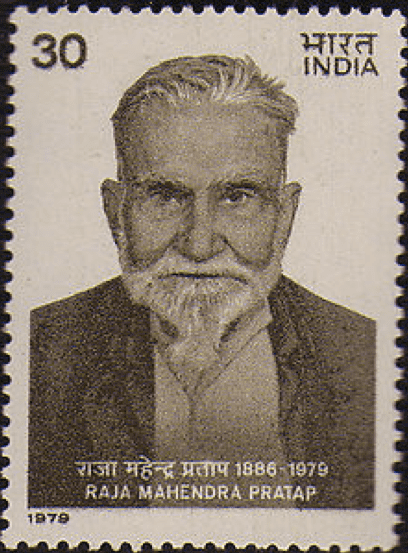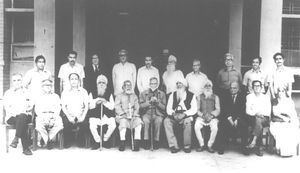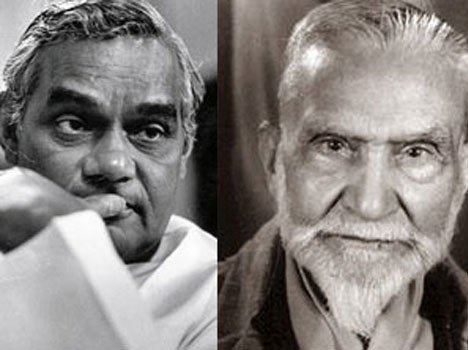Name Mahendra Pratap Role Journalist | Died April 29, 1979 | |
 | ||
Education Aligarh Muslim University | ||
Mahendra pratap singh inc damoh madhya pradesh
Raja Mahendra Pratap Singh (1 December 1886 – 29 April 1979) was a freedom fighter, journalist, writer, and Marxist revolutionary social reformist of India and President of first Provisional Government of India. He also formed the Executive Board of India in Japan in 1940 during the Second World War. He also took part in the Balkan War in the year 1911 along with his fellow students of MAO college. In recognition of his services, the government of India issued postage stamps in his honor.
Contents
- Mahendra pratap singh inc damoh madhya pradesh
- Quiz a t s khatima udham singh nagar dr mahendra pratap pandey
- Early life
- Education
- Nobel prize nomination
- Freedom movement
- Provisional Government of India
- In Japan
- Back to India
- References

Quiz a t s khatima udham singh nagar dr mahendra pratap pandey
Early life

Pratap was born to the Thenua gotra JAT Hindu princely family of state of Mursan in the Hathras District of Uttar Pradesh on 1 December 1886. He was the third son of Raja Ghanshyam Singh. At the age of three, Raja Harnarayan Singh of Hathras adopted him as his son. He was married to Balveer Kaur belonging to the ruling Sikh family of Jind princely state of Haryana (then in Punjab) in 1902 while studying in college. She died in 1925.
Education

In 1895 Pratap was admitted to the Government High School in Aligarh, but soon he switched over to the Muhammadan Anglo-Oriental Collegiate School which later on became Aligarh Muslim University Here he received his education under British Headmasters and Muslim teachers all from Muhammadan Anglo-Oriental College Aligarh founded by Sir Sayed Ahmad Khan. He could not complete his graduation and left MAO in 1905. In 1977, AMU, under V-C Prof A M Khusro, felicitated Mahendra Pratap at the centenary celebrations of MAO.

With this background he shaped into a true representative of secular society. To bring India to a par with European countries, Pratap established the free indigenous technical institute Prem Mahavidyalaya in his palace at Vrindavan on 24 May 1909.
Nobel prize nomination

He was nominated for the Nobel Peace Prize in 1932. N.A. Nilsson, his nominator, said about him-

"Pratap gave up his property for educational purposes, and he established a technical college at Brindaban. In 1913 he took part in Gandhi's campaign in South Africa. He traveled around the world to create awareness about the situation in Afghanistan and India. In 1925 he went on a mission to Tibet and met the Dalai Lama. He was primarily on an unofficial economic mission on behalf of Afghanistan, but he also wanted to expose the British brutalities in India. He called himself the servant of the powerless and weak."
While nominating for the Peace Nobel Prize, the nominator in a short biography, gave Singh’s status as follows: Singh "is the editor of the World Federation and an unofficial envoy of Afghanistan. The nominator wrote a short biography as well as international political activities. Particularly his role in the Indo-Turco-German mission was highlighted. For instance, Kaiser Wilhelm of Germany and Sultan Mohemmod Rishad of Turkey gave him letters for the Afghan King. He arrived in Kabul on Oct. 2, 1915. On December 1, 1915, a Provisional Government for India was organised. Pratap was declared as its President. In 1917 he went to Russia and met Trotsky at Leningrad. From there he came back to meet Kaiser and Sultan, to give the message of the King of Afghanistan. He passed some time in Budapest and Switzerland. He was brought by German aeroplane to Russia, where he met Lenin. From there he went to Afghanistan. King Amanullah sent him on a mission to China, Tibet, Japan, Siam, Germany, Turkey and the U.S.A. After an agreement with the British, the King lost interest in Pratap. In the end, it is summarized: “He is primarily on an unofficial economic mission of Afghanistan. However, being born as an Indian he also wanted to expose the British brutalities in that land of the idealist Americans. At this juncture, when the great freedom movement of India is developing with large momentum it is in the interest of the spiritually minded as well as business people to study carefully this new phenomenon of our social life. …. He hopes to achieve some practical results in this direction during his present sojourn in this country (U.S.A.). He is planning to establish an Afghanistan information bureau and an office of the World Federation at Washington, D.C. He just tries to do his duty according to his best understanding and leaves the working of fate to the Laws of Nature!" "It will be of interest to know – Why a Swede nominated Singh? The answer is to be found in the documents, which were sent with the nomination letter. Namely, Singh supported the idea of “World Federation”, about which N.A. Nilsson, propagated in 1910, as is evident from: “Fédération Internationale – Discours Au – xviii Congrés Universel de la paix (International Federation - Speeches in - xviii Universal Congress of Peace)."
Freedom movement
In spite of objections from his father-in-law, Pratap went to Kolkata in 1906 to attend the Congress session, and met several leaders involved in the Swadeshi movement, deciding to promote small industries with indigenous goods and local artisans. He was very much against social evils, especially untouchability. To eliminate this evil he dined with a Tamata family of Almora in 1911, and a Mehtar family of Agra in 1912. He was influenced by the speeches of Dadabhai Naoroji, Bal Gangadhar Tilak, Maharaja Baroda, and Bipin Chandra Pal, helping to make him a patriot who turned Swadeshi. He started the movement to burn the foreign-made clothes in his state.
After trying sincerely to liberate his motherland, on 20 December 1914 at the age of 28 Pratap left India for the third time, with a desire to liberate India from the clutches of British colonial rule by obtaining outside support.
In January 1915 on learning about his presence in Switzerland, Chatto alias Virendranath Chattopadhyay of the newly founded Berlin Committee (Deutsche Verein der Freunde Indien) requested Von Zimmermann of the German foreign ministry to get Pratap invited to Berlin. Already Chatto had sent a first mission to Afghanistan led by the Parsi revolutionary Dada Chanji Kersasp.
Informed about Chatto's activities from Shyamji Krishnavarma and Lala Hardayal, Pratap insisted on meeting the Kaiser Wilhelm II personally; Chatto rushed to Geneva to tell Pratap of the Kaiser's eagerness to see him, and they went to Berlin together. Har Dayal, too, followed them. Decorating Pratap with the Order of the Red Eagle, the Kaiser showed his awareness of the strategic position of the Phulkian States (Jind, Patiala and Nabha), if India was invaded through the Afghan frontier.
According to Pratap's wish, he was taken to a military camp near the Polish border to gain a firsthand knowledge of army policies and functioning. On 10 April 1915 accompanied by the German diplomat Von Hentig, Maulavi Barkatullah and a few other members, Pratap left Berlin, with due credentials from the Kaiser.
In Vienna the delegation met the Khedive of Egypt who during a conversation with Pratap expressed his desire to see the end of the British Empire. On their way, in Turkey they had an excellent visit with Enver Pasha, son-in-law of the Sultan and Defense Minister, who appointed a trusted military officer to guide them. They were received by Rauf Bey with a detachment of 2000 soldiers at Ispahan. They reached Kabul on 2 October and were greeted by Habibullah, having a number of discussions.
Provisional Government of India
On 1 December 1915 during World War I (his 28th birthday) Pratap established the first Provisional Government of India at Kabul in Afghanistan as a government-in-exile of Free Hindustan, with himself as President, Maulavi Barkatullah as Prime Minister, and Maulavi Abaidullah Sindhi as Home Minister, declaring jihad on the British. Anti-British forces supported his movement, but because of obvious loyalty to the British, the Amir kept on delaying the expedition to overthrow British rule in India.
Due to his revolutionary ideas Pratap had a good relationship with Lenin, who invited him to Russia after its liberation and welcomed him. By this time he had become a real threat to British rule in India, and the British Government of India put a bounty on his head, attacked his entire estate, and declared him a fugitive, causing him to flee to Japan in 1925.
In Japan
In Japan he published the 'World Federation Monthly Magazine' in 1929, trying his best to use the world war situations to free India. During Second World War he stayed at Tokyo in Japan and continued his movement from 'World Federation Centre' to free India from British rule. He formed the Executive Board of India in Japan in 1940 during Second World War. At last the British government relented and Raja Mahendra Pratap was permitted to come to India from Tokyo with respect.
Back to India
He returned to India after 32 years on the ship City of Paris, and landed at Madras on 9 August 1946. On reaching India he immediately rushed to Wardha to meet Mahatma Gandhi.
After independence also he continued his struggle for transfer of power to the common man. His vision was that the Panchayat Raj was the only tool which can put real power in the hands of people and reduce corruption and bureaucratic hurdles. He was the president of Indian Freedom Fighters' Association and was also the president of All India Jat Mahasabha. He was a member of the second Lok Sabha in 1957–1962. He was elected as an independent candidate from Mathura constituency defeating Bharatiya Jana Sangh (which would later evolved into BJP) candidate and the future Prime Minister of India, Atal Bihari Vajpayee in the 1957 Lok Sabha Elections.
He died on 29 April 1979.
